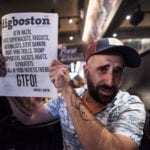
As petty and unfair as it can be to criticize a work of journalism for omissions, as opposed to on the grounds of what was actually reported, in recounting what went down around the “Free Speech” rally last weekend in Boston and in deconstructing the outrageously misleading narrative that’s since developed, it’s important to consider what was not covered at all, or at least not covered as extensively as are the dangerous right-wing ballbags who have been crashing America’s around-the-clock news cycle of late.
While some major news outlets did not even show up to a Black Lives Matter conference last week, leading up to Saturday’s festivities, many interviewers swooned around Boston Free Speech Coalition organizer John Medlar, effectively giving him a platform to both humanize his efforts and offer his trite sophomoric spiel about the First Amendment. In the time since, many journalists have strained themselves to applaud the right-wing instigators for their pacifism. The standard-setting Boston Globe ran stories that were favorable toward counterprotesters but that were also distant to the point of being aerial in scope. For opinions, one of the newspaper’s popular columnists wrote a puff piece about the police and the governor, both of which were primary points of contention for legions of marchers; their token righty, meanwhile, called the “Free Speech” crew a “couple dozen courteous people,” but on the other side saw nothing but 40,000 time-wasters who “showed up to denounce a nonexistent cohort of racists.” (How could there be racists on the Common if they don’t exist?)
On television, Boston 25 News led its 10 pm newscast with a voiceover claiming that counterdemonstrators caused problems, while reporting that the “Free Speech” circle was surprisingly peaceful. After a commercial break, a 25 reporter interviewed BPD Superintendent-in-Chief Daniel Linskey for the “police perspective,” only for Linskey to applaud his brothers in blue, black, and camouflage. “People were able to have their First Amendment right on both sides,” Linskey claimed. “BPD hit it out of the park today like they usually do.”
Commercial media needed to pin a medal on somebody, and that person wasn’t going to come from any of the many groups that peaceably managed tens of thousands of people. Nor would an award for saving the day go to the significantly few brash pro-Trump attendees, obviously. Unlike loudmouthed POTUS sycophants or black bloc anarchists and people marching with either of those groups, police made for an easy hero story. The problem, however, is that while there were certainly many skilled and even ethical cops in the mix—one platoon impressively removed a firearm from a guy in a Trump hat—that’s hardly the entire story.
All of which is why our team was out in unusual force, interviewing people, snapping several hundred pictures, and reaching for the root problems and issues that spurred a crowd half the size of Somerville’s whole population to converge on the Common.
FOR MORE OF FARAONE’S THOUGHTS ON THIS, CHECK OUT HIS DISPATCH-ANALYSIS IN THE NEW REPUBLIC
A Queens, NY native who came to New England in 2004 to earn his MA in journalism at Boston University, Chris Faraone is the editor and co-publisher of DigBoston and a co-founder of the Boston Institute for Nonprofit Journalism. He has published several books including 99 Nights with the 99 Percent, and has written liner notes for hip-hop gods including Cypress Hill, Pete Rock, Nas, and various members of the Wu-Tang Clan.

